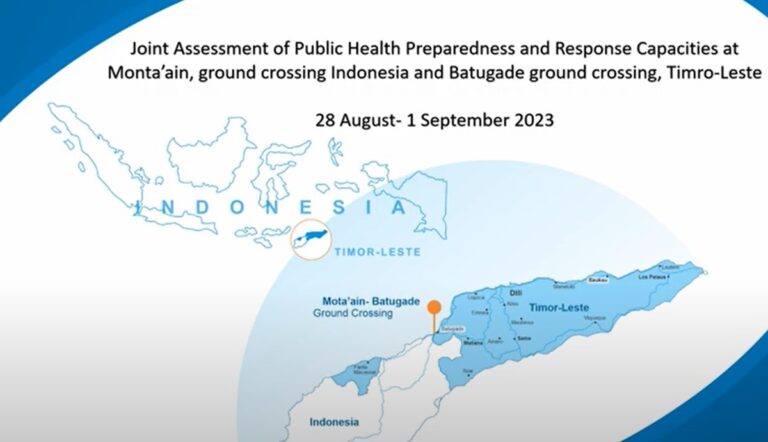Introduction
On August 28 to September 1, Indonesia and Timor-Leste conducted a comprehensive joint assessment of public health preparedness and response capacities at Mota’ain ground crossing in Indonesia and Batugade ground crossing in Timor-Leste. The assessment aimed to provide evidence-based insights to inform strategies, action plans, and policies. These insights are particularly crucial for strengthening core capacities at these designated ground crossing points, both under routine conditions and during emergencies.
Context and Components
Points of Entry (PoE) are critical for managing public health risks associated with travel and transport. They require robust capacities for surveillance, reporting, and response to both routine and emergency health events. Ground crossings, unlike airports and ports, often lack structure and are the requisite infrastructure hence vulnerable to the spread of diseases. The COVID-19 pandemic has highlighted the need for strong cross-border collaboration to manage health risks effectively.
Building on this need for enhanced preparedness, the assessment was specifically designed in the context of the COVID-19 pandemic and other emerging health emergencies. It aimed to offer technical support for bolstering both routine and emergency capacities at the Mota’ain-Batugade ground crossings. The initiative was attended by a total of 80 participants both physically and virtually including the observers from India and Nepal.
The assessment was organized into six key components, 1) A virtual orientation on the Ground Crossing Strategic Risk Assessment tool, aligned with the IHR (2005); 2) A situation analysis that included a desk review and stakeholder meetings to evaluate hazards, vulnerabilities, and risks; 3) Field visits to the Mota’ain and Batugade ground crossings for hands-on capacity and risk assessments; 4) A joint meeting to discuss the findings; 5) Risk identification at each crossing point, highlighting the need for collaborative surveillance and capacity building; and 6) A tabletop simulation exercise to practice outbreak response roles.
The assessment began with a virtual orientation on the Ground Crossing Strategic Risk Assessment tool. This tool is designed to facilitate timely and efficient risk management as per IHR (2005). Following the orientation, teams from both countries engaged in a comprehensive situation analysis, which included a desk review of available assessments and virtual meetings with relevant stakeholders to jointly analyze major hazards, vulnerabilities, and risks.
Field Visits Findings
Field visits to the Mota’ain and Batugade ground crossings were conducted to assess capacity and risk. The findings were later presented in a joint meeting. According to the risk matrix developed during the assessment, Batugade in Timor-Leste identified mosquito-borne diseases and flooding as significant risks, while Mota’ain in Indonesia identified COVID-19 as a very likely hazard with moderate impact. The assessment team observed a considerable difference in capacities for preparedness and response between Monta’ain and Batugade GCs. It was found that the coping capacity of Monta’ain GC is very high to manage the identified hazard. In contrast, the Batugade GC had a partial level of coping capacity to manage the identified hazards. These findings underscore the need for both countries to collaborate in enhancing surveillance mechanisms at these crossing points and to explore opportunities for capacity building. For this, both the countries have drafted a joint work plan on areas like outbreak investigation, designation of focal points, conducting simulation exercises, sharing surveillance data and information, drafting of contingency plans, and so on to tackle any future health emergencies and disasters.
Simulation Exercise and Conclusion
One of the most notable aspects of the assessment was the table-top simulation exercise. This exercise allowed participants to practice their roles and functions during a hypothetical outbreak.
The joint assessment not only serves to strengthen existing capacities but also guides discussions on planning, management, and technical cooperation among countries. Periodic risk assessments like this are crucial as they able early detection and action, assisting communities and stakeholders to be operationally ready for timely and effective response. These assessments are also imperative for drafting national action plans that outline priority actions to reduce vulnerabilities and address health risks specific to ground crossing.

